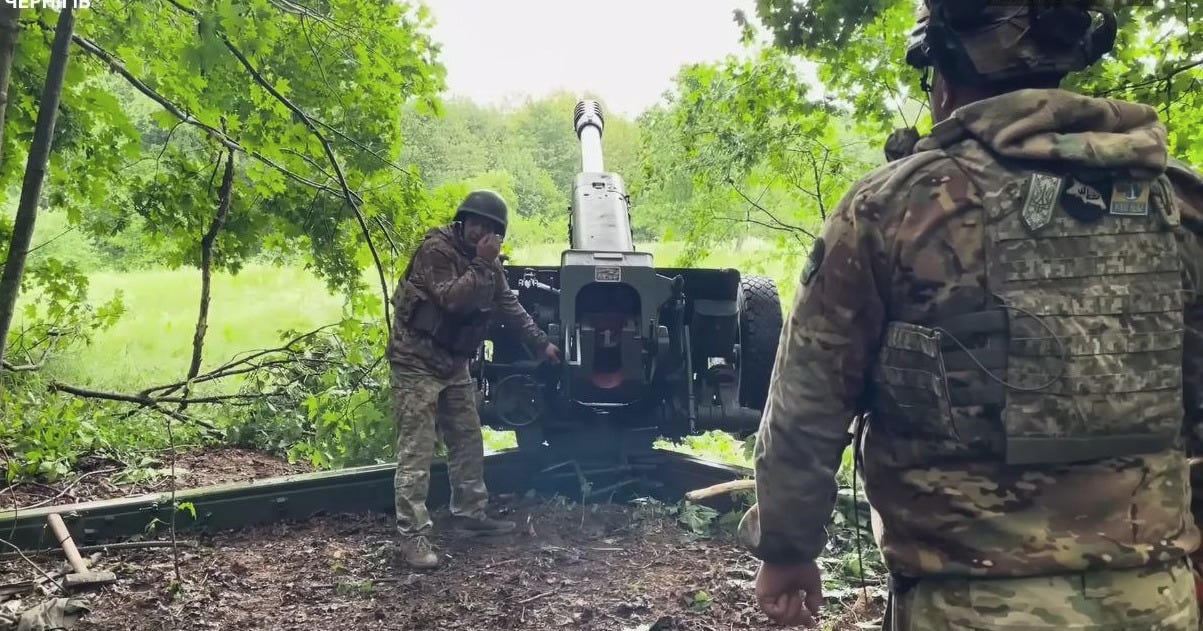Russia Has Massed 8 Elite Formations for a New March on Kyiv
The Russians' Sumy incursion could clear a path to the Ukrainian capital
Back in February, marines from the Russian 810th Naval Infantry Brigade stormed across the Ukraine’s northern border with Russia, opening a new front in Russia’s 41-month wider war on Ukraine.
Five months later, 50,000 Russians—who attacked almost entirely on foot without the support of heavy armor—are struggling to hang onto a 50-square-mile swathe of Ukraine’s Sumy Oblast. This despite intensive bombing by the Russian air force. (See bomb impacts in the video below.)
By now, parts or all of no fewer than seven elite Russian formations are in Sumy. And an eighth, the 810th NIB, is on its way back to the sector after a brief break.
But why are the Russians devoting so many of their best troops to their Sumy incursion when efforts elsewhere—in particular, around the city of Pokrovsk in the eastern Donbas region—seem to beg for reinforcement?
And why are the Ukrainians matching the Russian deployment, elite troop for elite troop, likewise risking Pokrovsk in the process?
It’s because the Russians hoped—and may still hope—to march on Kyiv, 170 miles west of Sumy city. That’s right: 39 months after the initial Russian push toward Kyiv ended in disaster for the invaders, the Russians still believe they could, with some luck, move on Ukraine’s capital.
“Lately, Russia’s slow progress in the Sumy region is being explained away by some as a diversion, an attempt to pull Ukrainian forces from Donbas, with no serious objectives in Sumy itself,” explained Tatarigami, the founder of the Ukrainian Frontelligence Insight analysis group. “That idea might seem reasonable for some—until you look closer.”
Russia’s best troops
“Since the start of the full-scale war, Russia has usually concentrated what it sees as elite assault units in directions it considers valuable, strategic or otherwise important,” Tatarigami added.
“The current makeup of Russian forces in Sumy direction”—four marine brigades or regiments, two air-assault divisions and two air-assault brigades—“speaks volumes.”
“These are the units Moscow tends to deploy mostly where it expects real gains,” Tatarigami explained. “These units are usually more combat-ready, and better suited for offensive operations than regular motor-rifle troops. In Russian military thinking, these are the formations that matter.”
“If [the] Sumy area were to fall, or if Russian forces pushed deep enough, it could open the way for an advance into Chernihiv Oblast,” Tatarigami pointed out. “That would put Kyiv under direct threat and force Ukraine to redeploy troops north, weakening other parts of the front.”
“And at that point, the conversation—both political and military—would shift.” Ukraine’s leaders would have to explain to their allies why they let the Russians march on the seat of power in Ukraine. “This would be disastrous for Ukraine,” Tatarigami explained.
Better to lose the ruins of Pokrovsk than give the Russians a shot at Kyiv, however long that shot might be.
To stop the Russians in Sumy, Ukraine deployed its own elite troops. In all, there are now no fewer than four Ukrainian mechanized brigades, three air-assault brigades or regiments and an assault regiment between the Russians and Sumy city.
Where the Russians attacked on foot owing to a shortage of armored vehicles and the growing vulnerability of the surviving vehicles to drones, the Ukrainians counterattacked with at least a few tanks and other armored vehicles—apparently counting on their drone advantage to protect the mechanized forces.
“Right now, Ukraine is holding its ground in Sumy, largely thanks to the resources allocated to this area,” Tatarigami noted. “That probably comes at the expense of other areas—most notably Pokrovsk, where the situation is steadily worsening.”
“Still, I’d argue this tradeoff is the right call,” Tatarigami wrote.
For now, the Russians are contained in their small salient in Sumy—and have even lost some ground to Ukrainian counterattacks. “While this might sound optimistic, there are still countless ways the situation could deteriorate,” Tatarigami warned. “Especially if North Korea were to cross the line and directly invade Ukraine.”
Tens of thousands of fresh North Korean infantry could be exactly what the Kremlin needs to credibly threaten Kyiv. Given the stakes, don’t be surprised to see even more of Ukraine’s best troops roll into Sumy to further squeeze the Russians in the oblast.
And don’t be surprised if Ukraine lets Pokrovsk fall, if Pokrovsk falling is the price of holding the line in Sumy.
Read more:
It Has Cost Russia Exactly One Armored Truck to Capture 60 Square Miles of Ukraine's Sumy Oblast
Parts of no fewer than 18 Russian regiments and brigades, each with 2,000 or more troops, have marched into northern Ukraine’s Sumy Oblast. And by “marched,” I mean literally marched.







Yes, even merely threatening Kyiv would be disastrous politically. Certainly it would jeopardize the little US support they still get. Not sure how the EU would react though. If we are to believe their intelligence services, the war in Ukraine helps them gain time to rearm before a Russian attack on NATO. A collapse of Ukraine would compress the timeline, perhaps unmanageably so.
Amassing troops in a noticeable manner during modern drone warfare is a bold strategy.
Bold indeed.